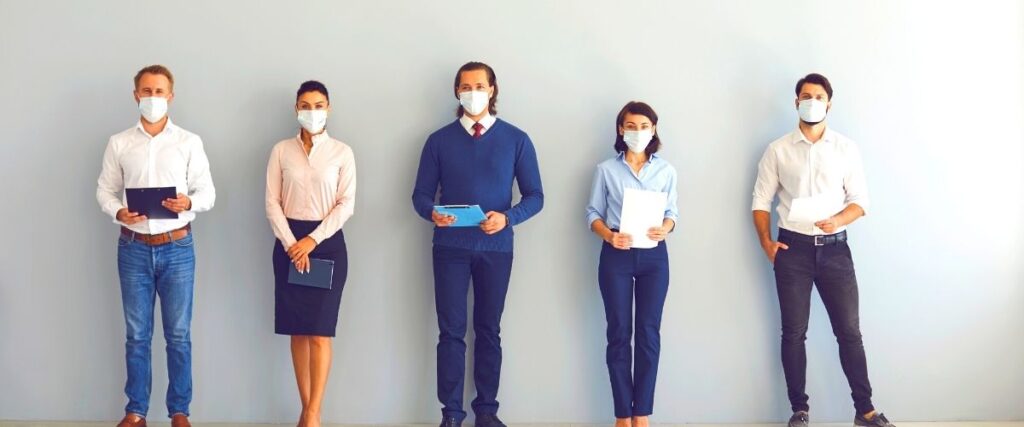[et_pb_section fb_built=”1″ _builder_version=”4.16″ _module_preset=”default” custom_padding=”0px|||||” global_colors_info=”{}”][et_pb_row _builder_version=”4.16″ _module_preset=”default” custom_padding=”0px|||||” global_colors_info=”{}”][et_pb_column type=”4_4″ _builder_version=”4.16″ _module_preset=”default” global_colors_info=”{}”][et_pb_text _builder_version=”4.17.4″ _module_preset=”default” hover_enabled=”0″ global_colors_info=”{}” sticky_enabled=”0″]
The Spring of 2022 marks the beginning of the third year of the COVID-19 pandemic. While many Americans believe the pandemic is over with life returning to pre-pandemic normal, it is certainly not behind us. The landscape of the pandemic has merely shifted to a new “normal”. This new normal includes continuing mask mandates, vaccine requirements (including boosters) at some public and private businesses and schools and continued supplemental COVID-19 paid sick leave. Although the pandemic may appear over when gathered in large groups such as a sporting event, the federal, state and local requirements related to COVID are proof the pandemic is still ongoing. Below provides a few of the current COVID-19 requirements.
COVID-19 Supplemental Paid Sick Leave
In February 2022, Governor Newsom implemented a supplemental paid sick leave for COVID-19 related absences. A covered employee is entitled to at least 40 hours but no more than 80 hours of supplemental paid sick leave between January 1, 2022 and September 30, 2022 for COVID-19 related absences. Examples of such absences are: needing to quarantine due to possible exposure to COVID-19, attending a COVID-19 vaccine appointment for themselves or for a family member, experiencing COVID-19 symptoms and seeking a medical diagnosis, caring for a family member, or caring for a child whose school or place of care is closed due to reasons related to COVID-19.
A key component of this supplemental paid sick leave is its retroactivity. An employee is able to request paid sick leave for a COVID-19 related absence between January 1, 2022 and February 28, 2022, prior to the implementation of the legislation. While the prior COVID-19 supplemental paid sick leave expired on September 30, 2021, there is nothing to suggest an employee can request paid time off for COVID-19 related leave taken between October 1 and December 31, 2021.
Testing and Mask Requirements
CalOSHA continues to modify protocols with regard to testing, close-contact, and return-to-work procedures and has revised certain terms, such as what constitutes a “face covering” to adapt to the changing landscape. The current Emergency Temporary Standards (ETS) are in effect until December 31, 2022. The key takeaway from this version of the ETS is it applies to employees without regard of vaccination status. Employers can require employees to submit proof of vaccination and require employees to be vaccinated against COVID-19. Additionally, employers can require employees to wear a face covering, as long as an accommodation is made for those who cannot wear face coverings because of a condition or disability. However, face coverings are no longer mandatory for unvaccinated workers under the new ETS.
Also of note under the new ETS is that COVID-19 testing must be made available to all employees with COVID-19 symptoms.
Workplace Safety – Civil Penalties
In September 2021, Governor Newsom signed SB 606, which allows the California Division of Occupational Safety and Health (CalOSHA) to issue company-wide citations for multiple workplace outbreaks of COVID-19. California inspectors may levy a civil penalty against those who are cited between an approximate range of $9,000 to $125,000 for willful violations of workplace safety.
Companies are liable for an automatic penalty, if three or more employees require hospitalization from a COVID-19 outbreak that occurred at their workplace. These penalties are designed to incentivize companies to maintain safe and healthy work environments.
More Changes to the Emergency Temporary Standards (ETS)
To note additional changes under the new ETS, employers should carefully review the updated version to see where their policies and procedures need updating. The new ETS can be reviewed in Spanish here. Among other additional changes, for example, cleaning and disinfecting requirements were removed. Employers can also view a comprehensive list of changes from the previous ETS here. Maier Law Group can provide more guidance if needed to clarify the ever-evolving ETS. Email Info@maierlawgroup.com for a quick response.
This article has been prepared for general informational purposes only and does not constitute advertising, solicitation, or legal advice. If you have questions about a particular matter, please contact the Maier Law Group directly.
[/et_pb_text][/et_pb_column][/et_pb_row][et_pb_row _builder_version=”4.16″ _module_preset=”default” global_colors_info=”{}”][et_pb_column type=”4_4″ _builder_version=”4.16″ _module_preset=”default” global_colors_info=”{}”][et_pb_cta title=”Protea Financial Is Here to Help with Your Business” button_url=”https://proteafinancial.com/contact/” url_new_window=”on” button_text=”Contact Protea Financial Today” _builder_version=”4.17.3″ _module_preset=”default” background_color=”#000000″ global_colors_info=”{}”]
Business has changed and COVID in the workplace is something we all must face. To find ways of simplifying your work, reach out to us today!
[/et_pb_cta][/et_pb_column][/et_pb_row][/et_pb_section]

